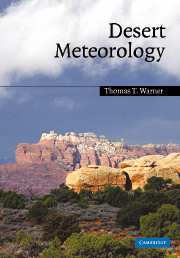Book contents
- Frontmatter
- Contents
- Preface
- Acknowledgements
- 1 Introduction
- 2 The atmospheric dynamics of deserts
- 3 The climates of the world deserts
- 4 Atmospheric and surface energy budgets of deserts
- 5 Surface physics of the unvegetated sandy desert landscape
- 6 Vegetation effects on desert surface physics
- 7 Substrate effects on desert surface physics
- 8 Desert-surface physical properties
- 9 Numerical modeling of desert atmospheres
- 10 Desert boundary layers
- 11 Desert microclimates
- 12 Dynamic interactions among desert microclimates
- 13 Desert rainfall
- 14 Anthropogenic effects on the desert atmosphere
- 15 Changes in desert climate
- 16 Severe weather in the desert
- 17 Effects of deserts on the global environment and other regional environments
- 18 Desertification
- 19 Biometeorology of humans in desert environments
- 20 Optical properties of desert atmospheres
- Appendix A Glossary of meteorological and land-surface terms
- Appendix B Abbreviations
- Appendix C Units, numerical constants, and conversion factors
- Appendix D Symbols
- Appendix E Maps of the world
- Hints to solving some problems and exercises
- References
- Index
- Plate section
- References
6 - Vegetation effects on desert surface physics
Published online by Cambridge University Press: 04 September 2009
- Frontmatter
- Contents
- Preface
- Acknowledgements
- 1 Introduction
- 2 The atmospheric dynamics of deserts
- 3 The climates of the world deserts
- 4 Atmospheric and surface energy budgets of deserts
- 5 Surface physics of the unvegetated sandy desert landscape
- 6 Vegetation effects on desert surface physics
- 7 Substrate effects on desert surface physics
- 8 Desert-surface physical properties
- 9 Numerical modeling of desert atmospheres
- 10 Desert boundary layers
- 11 Desert microclimates
- 12 Dynamic interactions among desert microclimates
- 13 Desert rainfall
- 14 Anthropogenic effects on the desert atmosphere
- 15 Changes in desert climate
- 16 Severe weather in the desert
- 17 Effects of deserts on the global environment and other regional environments
- 18 Desertification
- 19 Biometeorology of humans in desert environments
- 20 Optical properties of desert atmospheres
- Appendix A Glossary of meteorological and land-surface terms
- Appendix B Abbreviations
- Appendix C Units, numerical constants, and conversion factors
- Appendix D Symbols
- Appendix E Maps of the world
- Hints to solving some problems and exercises
- References
- Index
- Plate section
- References
Summary
The difficulty in surviving the severe weather and climate of the desert sometimes stimulates development of a strict desert social code of honor, solidarity, and hospitality. For example
Theodore Lascaris, an emissary of Napoleon, and his Syrian dragoman, Fathallah Sayigh, were given shelter by a poor old widow of the Sardiyya Bedouin in Jordan, who slaughtered her one and only sheep in their honour. “Grandmother,” they said to her, “why such waste?” To which she replied: “If you entered the dwelling of a living person and did not find hospitality there, it would be as though you had paid a visit to the dead.”
Joseph Chelhod Islands of Welcome in a Sea of Sand (1990)The mesquite is God's best thought in all this desertness. It grows in the open, is thorny, stocky, close grown, and iron-rooted. Long winds move in the draughty valleys, blown sand fills and fills about the lower branches, piling pyramidal dunes, from the top of which the mesquite twigs flourish greenly. Fifteen or twenty feet under the drift, where it seems no rain could penetrate, the main trunk grows, attaining often a yard's thickness, resistant as oak.
Mary Austin, American naturalist and writer The Land of Little Rain (1903)Even though the expression “desert vegetation” may seem contradictory, nothing could be further from the truth in some places. Deserts, in fact, may have a richness of flora and fauna that is unparalleled in more humid areas such as woodlands.
- Type
- Chapter
- Information
- Desert Meteorology , pp. 219 - 244Publisher: Cambridge University PressPrint publication year: 2004

